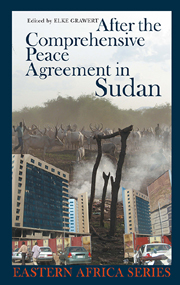Book contents
- Frontmatter
- Contents
- List of Tables & Figures
- Editor's Preface
- Notes on Contributors
- List of Acronyms
- Map of Sudan
- 1 Introduction
- I Implementation & Potential of the CPA
- II Challenges Facing Post-war Societies in Sudan
- III The CPA in its Sub-regional Context
- 11 Changes in Gambella, Ethiopia after the CPA
- 12 Ethiopian Federalism Seen from the Regional State of Gambella
- 13 From CPA to DPA
- 14 Challenges of Sub-regional Peace after the CPA
- IV Beyond the CPA
- Index
- EASTERN AFRICAN STUDIES
13 - From CPA to DPA
‘Ripe for Resolution’, or Ripe for Dissolution?
from III - The CPA in its Sub-regional Context
Published online by Cambridge University Press: 05 April 2013
- Frontmatter
- Contents
- List of Tables & Figures
- Editor's Preface
- Notes on Contributors
- List of Acronyms
- Map of Sudan
- 1 Introduction
- I Implementation & Potential of the CPA
- II Challenges Facing Post-war Societies in Sudan
- III The CPA in its Sub-regional Context
- 11 Changes in Gambella, Ethiopia after the CPA
- 12 Ethiopian Federalism Seen from the Regional State of Gambella
- 13 From CPA to DPA
- 14 Challenges of Sub-regional Peace after the CPA
- IV Beyond the CPA
- Index
- EASTERN AFRICAN STUDIES
Summary
PETER WOODWARD
Peace, with the signing of the CPA in January 2005 after so many years of conflict in southern Sudan, seemed cruelly displaced by conflict in Darfur and the apparent failure of the Darfur Peace Agreement (DPA) in April 2006. But it also raised the questions this chapter seeks to address. Why was the CPA possible? What connection, if any, has there been between the CPA and the DPA? Why has the DPA not taken hold? And what are the implications of the two processes for each other?
Why was the CPA possible?
When the CPA was signed in 2005, Sudan had had over 30 years of civil war in the south, one peace agreement, Addis Ababa in 1972, that had collapsed, and numerous failed peace talks. Yet with all this failure (in actual fact partly because of it), a somewhat surprised world applauded the agreement. As so often, any attempt at explanation must embrace the national, regional and broader international context that made the conflict in the South ‘ripe for resolution’, a phrase SPLM/A leader John Garang used himself after the signing (Deng/Zartman 1991).
- Type
- Chapter
- Information
- After the Comprehensive Peace Agreement in Sudan , pp. 232 - 240Publisher: Boydell & BrewerPrint publication year: 2010



